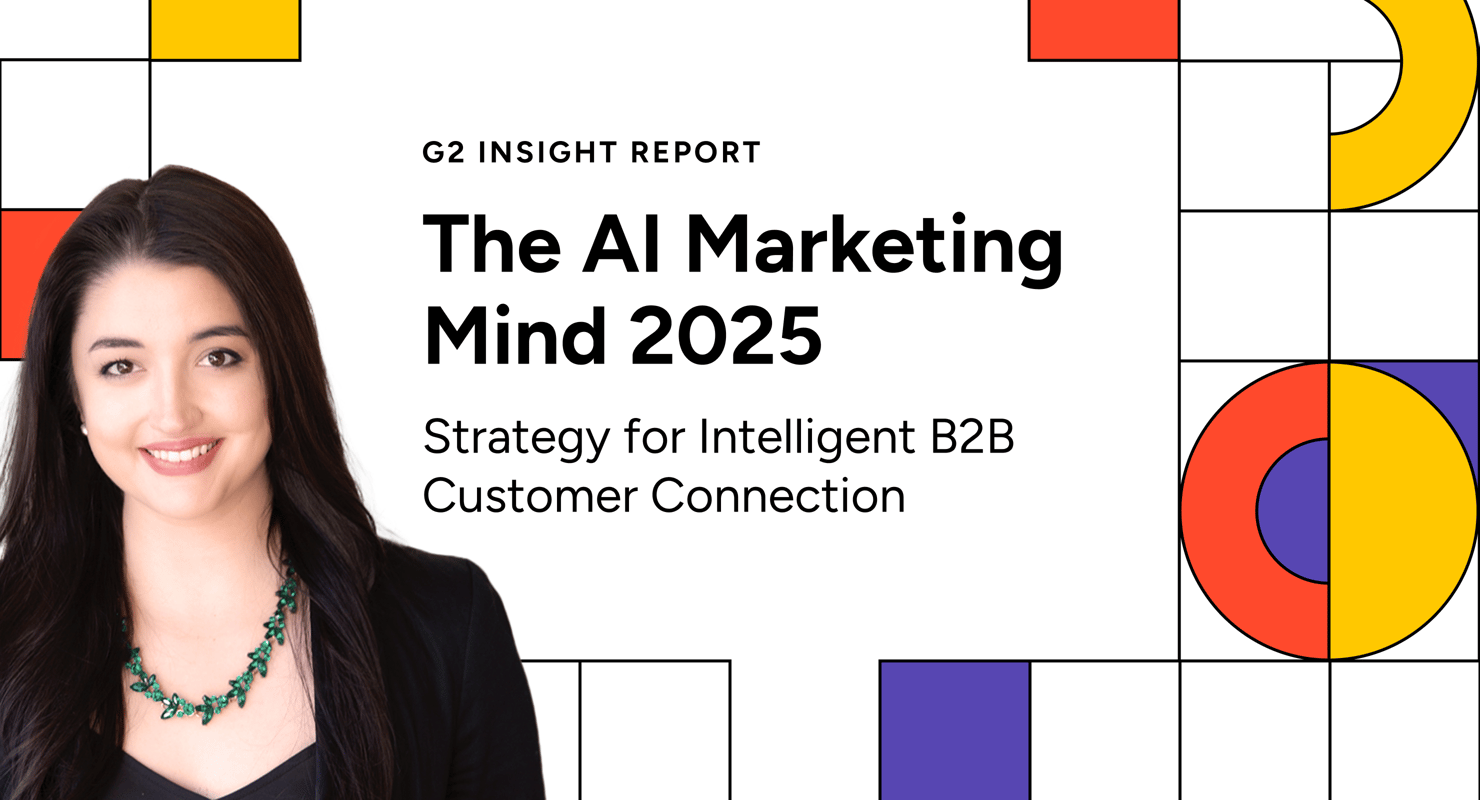How does your marketing strategy look today versus a year ago?
The use of AI has dramatically evolved over the past year, with both its applications and frequency of use increasing substantially. This trend shows no signs of slowing down. In fact, within the next eight months, your marketing strategy's competitive edge will largely depend on the AI solutions you're implementing or planning to adopt.
Introducing a new G2 Research Insight Report series: starting with the AI Marketing Mind
As marketers, we know that using AI correctly is all about blending science and creativity. And because of this, I’m so excited to announce that today, G2 has published my new report: “The AI Marketing Mind 2025: Strategy for Intelligent B2B Customer Connection.”
This new report — incorporating industry research, expert interviews, and market analysis — is the first in a new Research Insights series from G2. Featuring quotes and data from industry-leading companies like Profound, Salesforce, and Jasper, this report is designed to be a tool in your toolbox as a B2B marketer navigating how to make the most of AI while maintaining authentic customer connections.
Read on for a teaser of the AI Marketing Mind’s four critical focus areas.
Four focus areas to action and scale
At G2, we know how important it is to keep our finger on the pulse of AI’s relevance and how it’s fundamentally reshaping B2B marketing by enabling businesses to harness vast amounts of data for actionable insights, accelerate workflows, and enhance customer engagement.
Let’s explore the four areas that will be impacted by AI and what you can expect to learn more about in my full report.
1. The evolution of content creation
One of the first ways marketers began experimenting with AI is with content creation. And while it may be one of the easiest paths to integrate, it’s not easy to produce high-quality, personalized content at scale.
When done correctly, using AI in content creation can influence brand trust and foster a strong connection with customers. For this, marketers should:
- Think of writing assistants as the hands while the human creative team is the brain.
- Consider how AI can help rather than hinder the creative process.
- Use AI tools to break the barrier to entry for high-quality video.
- Refine their content strategy to better meet customer expectations.
Tip: Discover which AI tools you should use for content creation today, plus use cases to expect over the next five years.
2. AI analytics can help companies retain customers
As marketers, data surrounding customer behavior, preferences, and pain points make us tick – and we know this information is a must-have for retention and growth. Instead of leaving this data in silos, AI-driven features with predictive, digital, or account-based analytics can help businesses anticipate customer needs and respond proactively.
AI analytics can also assist in areas that influence customer connections, like providing hyper-personalized account-based marketing (ABM) and customer sentiment analysis — while also serving as a sales intelligence tool.
Tip: Learn which AI tools can reduce churn and work smarter with your orgs sales team – and how AI-driven personalization will increase B2B buyer engagement in the future.
3. AI personalization and buyer engagement go hand-in-hand
Next I dive into personalization practices emboldened with AI and how they’re the potential answer to a personalization prayer. How should we balance the level of personalization customers want without compromising user trust or brand reputation? Since customer needs go hand-in-hand with their journey with a brand, personalization should be even more top of mind.
AI can help by delivering tailored content, messaging, and interactions at every stage of the buyer journey. By personalizing outreach and experiences at scale, AI can foster stronger relationships with prospects and existing customers, reduce friction in the buying process, and increase engagement.
It’s important to remember that personalization is no longer just about creating content that resonates at the right time; it's also about meeting your customers where they wouldn’t expect you.
Tip: Find out which AI tool is best for intent-driven engagement and adaptive channel personalization and my prediction for how aggressive adopters of AI-powered automation will reduce marketing operational costs.
4. Adopting AI can reduce marketing operational costs
When marketing operations are more efficient, your team can focus on creating human-to-human value versus repetitive tasks. Some ways to do this include automated multi-touch nurturing, real-time ad optimization, and embracing predictive co-pilots.
Tip: Which AI tools can automate multi-touch attribution and assist with real-time ad optimization? Find out.
Predictions and prescriptions for 2025
Of course, effectively integrating AI into marketing strategies requires balancing automation efficiency and maintaining authentic human connections with customers.
In my report, discover even more about how to embrace AI to connect at the most authentic level with the people who matter most. Download the full AI Marketing Mind 2025 report to get actionable strategies for intelligent B2B customer connection, and stay tuned for future reports in our G2 Research Insights series!
Appendix
Grammarly, Canva, Synthesia, ActiveCampaign, Adroll, HubSpot Marketing Hub, Insider, Adobe Journey Optimizer, PathFactory, Chattermill, Adobe Marketo Engage, Drift, and Factors.AI.

 by Godard Abel
by Godard Abel
 by Noor Hamouda
by Noor Hamouda
 by Katlin Hess
by Katlin Hess